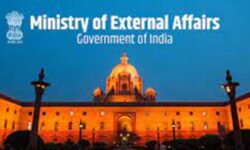NEW DELHI:
A wide swath of the millennia-old Indian civilization came alive through a cluster of artefacts of astonishing brilliance as the National Museum today began a nearly two-month transcontinental exhibition that takes the viewers on an intriguing and exhilarating trip of the country’s spectacular past and its links with the outside world since antiquity.
‘India and The World: A History in Nine Stories’, the first of its kind event in India, marks an unprecedented collaboration in museum exhibition with the British Museum, London; National Museum, New Delhi; Chhatrapati Shivaji Maharaj Vastu Sanghahalaya (CSMVS), Mumbai; and some 20 private collections pooling in their resources for the phenomenal show.
Chief Guest Ram Bahadur Rai, President, IGNCA, formally inaugurated the exhibition, unveiling a unique line-up of around 200 ancient and modern exhibits which offer a chronological and thematic depiction of the evolution of India with multiple expressions of art and artefacts, stories and aesthetics.
Some of the eye-popping objects on display include the oldest known hand-axe in the world (1.7-1.07 million years) from Attirampakkam, Tamil Nadu; a replica of the Dancing Girl of Mohenjodaro (2500 BC); a gold-horned Harappan humped bull (1800 BC); a Mughal miniature-inspired work by Rembrandt; an Ashokan Edict (250 BC); and an imprint of the Constitution of India having more than 50 paintings supervised by the renowned artist Nandalal Bose.
Rai described the exhibition as a “journey through history”, taking Indians to “moments in history that are a matter of pride for us”.
“This is also a celebration of cultural exchanges and a moment to remember that our civilization has existed for millions of years and what it has given to the world in terms of culture, science and spirituality,” he said.
In a message, Matt Hancock, UK Secretary of State for Digital, Culture, Media and Sport, said: “Culture is at the heart of the UK-India relationship and the living bridge that connects our two nations. This exhibition not only explores our shared history, but shows how our institutions are building partnerships that will last well into the future. I am delighted that it has reached new audiences in Delhi and I look forward to seeing it myself when I host a launch event next week.”
A host of dignitaries, including British High Commissioner to India Dominic Asquith; L.N. Sharma, Chief Post Master General, Delhi Circle, Dr. Hartwig Fischer, Director, British Museum; and Sabyasachi Mukherjee, Director General, CSMVS were present at the inauguration.
Dr Mahesh Sharma, Minister for Culture, and Raghavendra Singh, Secretary (Culture) were unable to attend the inaugural due to pressing engagements, but they conveyed their good wishes for the success of the exhibition.
The 7-week epical exhibition at the museum, which comes after a successful showing in Mumbai, commemorates 70 years of Indian independence and a year of major cultural exchange between India and the UK. By offering 124 objects, the British Museum has become the biggest lender for the show and some of these exhibits have never been shown in India earlier.
National Museum Director-General Dr B R Mani in his welcome address said the exhibition has introduced new features in its Delhi leg, including Braille tactile feature for the visually challenged “for creating a tangible experience and a wide range of connections with the objects”.
He said the newly renovated National Museum library has set aside a collection of books in Hindi and English relating to the exhibition for scholars and interested visitors.
Among the iconic objects lent by the British Museum are the Greek copy of the Roman discus-thrower Discobolus (2nd AD), Olduvai handaxe, Head in the style of Alexander, a fishtail dagger, and the 2002 Throne of Weapons made from melted down machine guns and rifles used in Mozambique’s civil war.
The exhibition has objects representing the focal theme in the nine specially-designed galleries, each representing a pivotal moment in history: Shared Beginnings (1,700,000 years ago to 2000 BC), First Cities (3000–1000 BC), Empire (600 BC – AD 200), State and Faith (AD 100–750), Picturing the Divine (AD 200–1500), Indian Ocean Traders (AD 200-1650), Court Cultures (AD 1500–1800), Quest for Freedom (1800–Present), and Time Unbound.
In each gallery, about 6-7 Indian objects are centrally placed, and these are encircled by objects from world cultures, belonging to the same period, for comparable viewing within a global context. Conversations between objects from different places and times, between cultures and nations, are at the heart of the stories told by the exhibition.
Dr. Hartwig Fischer, Director, British Museum said India and the World represented a new approach and new model of museum exhibition that sets one culture in a global context of shared histories and common ground, looking at similarities and differences and combing the strength of their collections and expertise.
“This is a history you will not find in textbooks and schools, in that provides a better understanding of how one culture has been in communication and exchange with another. It marks a new dimension and new stage in cooperation between global museums,” he said.
Sabyasachi Mukherjee, Director General, CSMVS, described “India and the World” as a conversation between objects, cultures, religion and human minds. “The nine galleries in the exhibition highlight nine iconic moment in Indian history in the context of happenings in other parts of the world,” he said. “It is articulation of India’s place in the world and provides an opportunity for discourse and cross-cultural encounters.”
On the occasion, National Museum released three books: Divyambara: Masterpieces of Costume from the National Museum Collection by Lotika Varadarajan; Kaivalyam: Jain Painting in the National Museum by Dr S.V. Tripathi and Pawan Jain; and An introduction to the Indus Valley Civilization by Sanjib Kumar Singh and Gunjan Kumar Srivastava.
Unveiling a special postal cover brought out by the Department of Post, L.N. Sharma said the exhibition showcases Indian history from two million years ago to the present day, not just displaying the regional connects but global links that provide visitors with a lifetime opportunity and a great learning experience.
Souvenirs including T-Shirt, Designer Jewellery and Canvas Bag with the logo of National Museum were also released. Dr Anamika Pathak, Curator and In Charge of Exhibition, National Museum proposed the vote of thanks.
Conceived over a period of two years of intense planning and curatorial brainstorming, ‘India and the World’ has been jointly curated by a team in the UK and India with Jeremy David Hill from the British Museum and Prof. Naman P Ahuja of Jawaharlal Nehru University, Delhi as the co-curators.
The exhibition is being backed by events such as curatorial walks and talks, besides educational activities like stone tool, Harappan seal and bead making, currency design, scroll painting, clay moulding, blindfold photography and sculpture making, keeping in mind audiences across ages and tastes. There will also be theatre workshops, guided tours, thematic walks for kids and events like treasure hunt and online weekly quiz on the event’s website (https://www.indiaandtheworld.org).
A special feature of the exhibition is its tactile exhibits which, together with supporting aids, provide a multi-sensory experience to the audience. For this initiative, National Museum is collaborating with Access for ALL, Delhi Art Gallery and Radio Mirchi.
The exhibition, which is supported by the Union Culture Ministry, Tata Trusts, the Getty Foundation and the Newton Bhabha Fund, will run till June 30 from 10 am to 6 pm, except on Mondays and public holidays.




